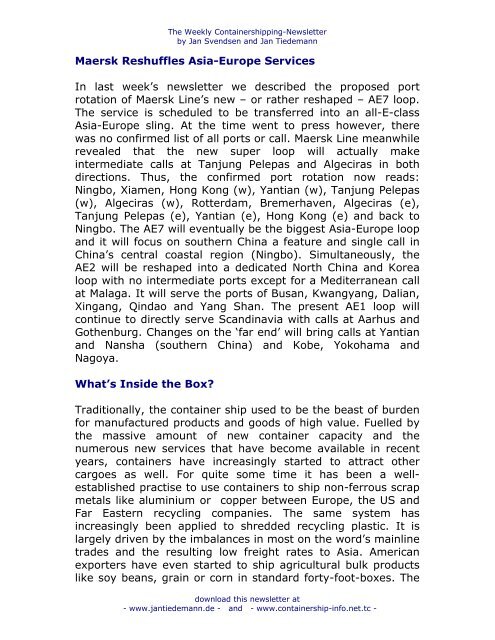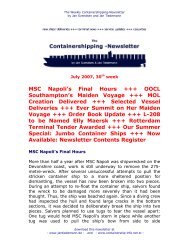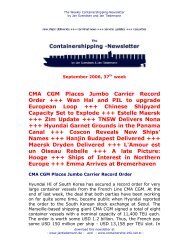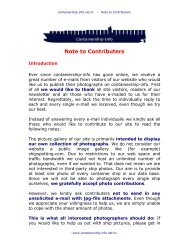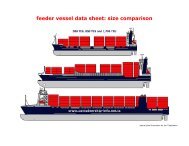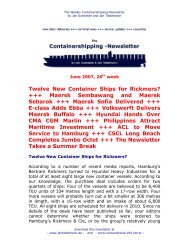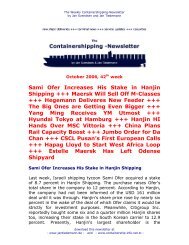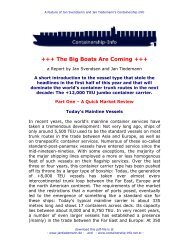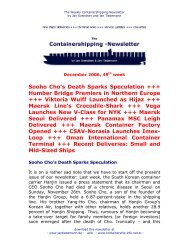Jan Svendsen and Jan Tiedemann - Containership-Info
Jan Svendsen and Jan Tiedemann - Containership-Info
Jan Svendsen and Jan Tiedemann - Containership-Info
You also want an ePaper? Increase the reach of your titles
YUMPU automatically turns print PDFs into web optimized ePapers that Google loves.
The Weekly <strong>Containership</strong>ping-Newsletter<br />
by <strong>Jan</strong> <strong>Svendsen</strong> <strong>and</strong> <strong>Jan</strong> <strong>Tiedemann</strong><br />
Maersk Reshuffles Asia-Europe Services<br />
In last week’s newsletter we described the proposed port<br />
rotation of Maersk Line’s new – or rather reshaped – AE7 loop.<br />
The service is scheduled to be transferred into an all-E-class<br />
Asia-Europe sling. At the time went to press however, there<br />
was no confirmed list of all ports or call. Maersk Line meanwhile<br />
revealed that the new super loop will actually make<br />
intermediate calls at Tanjung Pelepas <strong>and</strong> Algeciras in both<br />
directions. Thus, the confirmed port rotation now reads:<br />
Ningbo, Xiamen, Hong Kong (w), Yantian (w), Tanjung Pelepas<br />
(w), Algeciras (w), Rotterdam, Bremerhaven, Algeciras (e),<br />
Tanjung Pelepas (e), Yantian (e), Hong Kong (e) <strong>and</strong> back to<br />
Ningbo. The AE7 will eventually be the biggest Asia-Europe loop<br />
<strong>and</strong> it will focus on southern China a feature <strong>and</strong> single call in<br />
China’s central coastal region (Ningbo). Simultaneously, the<br />
AE2 will be reshaped into a dedicated North China <strong>and</strong> Korea<br />
loop with no intermediate ports except for a Mediterranean call<br />
at Malaga. It will serve the ports of Busan, Kwangyang, Dalian,<br />
Xingang, Qindao <strong>and</strong> Yang Shan. The present AE1 loop will<br />
continue to directly serve Sc<strong>and</strong>inavia with calls at Aarhus <strong>and</strong><br />
Gothenburg. Changes on the ‘far end’ will bring calls at Yantian<br />
<strong>and</strong> Nansha (southern China) <strong>and</strong> Kobe, Yokohama <strong>and</strong><br />
Nagoya.<br />
What’s Inside the Box?<br />
Traditionally, the container ship used to be the beast of burden<br />
for manufactured products <strong>and</strong> goods of high value. Fuelled by<br />
the massive amount of new container capacity <strong>and</strong> the<br />
numerous new services that have become available in recent<br />
years, containers have increasingly started to attract other<br />
cargoes as well. For quite some time it has been a wellestablished<br />
practise to use containers to ship non-ferrous scrap<br />
metals like aluminium or copper between Europe, the US <strong>and</strong><br />
Far Eastern recycling companies. The same system has<br />
increasingly been applied to shredded recycling plastic. It is<br />
largely driven by the imbalances in most on the word’s mainline<br />
trades <strong>and</strong> the resulting low freight rates to Asia. American<br />
exporters have even started to ship agricultural bulk products<br />
like soy beans, grain or corn in st<strong>and</strong>ard forty-foot-boxes. The<br />
download this newsletter at<br />
- www.jantiedemann.de - <strong>and</strong> - www.containership-info.net.tc -


